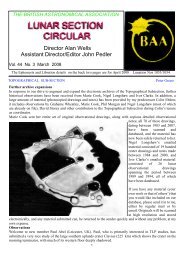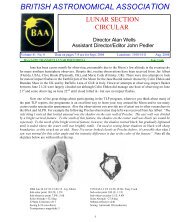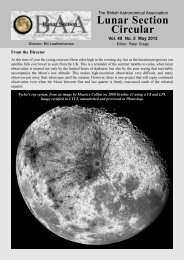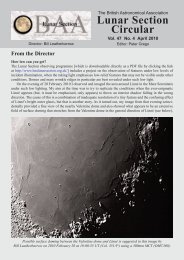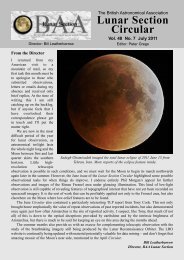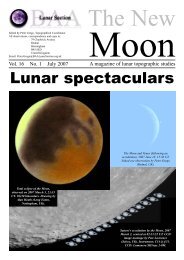A magazine of lunar topographic studies Vol. 17 No. 2 December 2008
A magazine of lunar topographic studies Vol. 17 No. 2 December 2008
A magazine of lunar topographic studies Vol. 17 No. 2 December 2008
- No tags were found...
You also want an ePaper? Increase the reach of your titles
YUMPU automatically turns print PDFs into web optimized ePapers that Google loves.
sunset, it couldn’t do so at sunrise. In factthe shadows falling eastwards from thehigher part <strong>of</strong> the hill at sunset largelyobscure any chance observing this illusion at<strong>lunar</strong> dusk.Other features <strong>of</strong> interest in this regioninclude the narrower Rima Hippalus IV. Thismuch more difficult to observe rille runsnorth eastwards diagonally from the aforementionedsmall hill for some distance, andis a line <strong>of</strong> demarcation between two areas<strong>of</strong> differing tone. To the south <strong>of</strong> this, andalmost parallel to it, is another even finer,and unnamed difficult to observe rille. Asthe Rima Hippalus II and III run north fromAgatharchides A, there is a fairly broad butshallow rille connecting the two diagonallyat roughly the same angle as the RimaHippalus IV further south. This is shownfaintly on p.80 <strong>of</strong> The Times Atlas <strong>of</strong> theMoon (LAC 94).To sum up, this is a particularly interestingregion <strong>of</strong> the Moon to study, and one doesn’tneed a particularly large telescope toobserve most <strong>of</strong> the finer features mentionedabove. Perhaps those observers that likeCCD imaging as well as a bit <strong>of</strong> a challenge,could attempt to unravel and explain themystery <strong>of</strong> the ‘bendaround’ rille?Right: Part <strong>of</strong> LAC 94 (featured on p.79-80<strong>of</strong> The Times Atlas <strong>of</strong> the Moon) showingthe area to the east <strong>of</strong> Hippalus and most <strong>of</strong>the features mentioned in the article. <strong>No</strong>rthis at top. Credit: NASA.Below: Detail from a map <strong>of</strong> the Hippalusarea by the great observer P. B.Molesworth (1867-1906), presented withnorth at the top for easier comparison withthe LAC map.Page 10 The New Moon <strong>December</strong> <strong>2008</strong>



